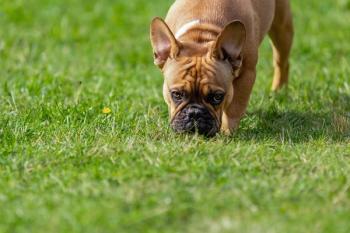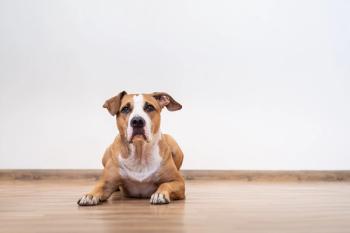
Managing pneumothorax (Proceedings)
Pneumothorax is defined as free air in the pleural space. Normal intra-pleural pressure is about - 5 cmH20, which means that in order to equilibrate pressures, air from either the atmosphere, or the lung will equilibrate rapidly with the pleural space. Pneumothorax can be further characterized as traumatic, spontaneous and iatrogenic.
Pneumothorax is defined as free air in the pleural space. Normal intra-pleural pressure is about - 5 cmH20, which means that in order to equilibrate pressures, air from either the atmosphere, or the lung will equilibrate rapidly with the pleural space. Pneumothorax can be further characterized as traumatic, spontaneous and iatrogenic. The recommendations for management of pneumothorax differ based upon the classification of the cause.
Traumatic pneumothorax results from some sort of injury to the chest; it may be further divided into open where there is a wound connecting the chest cavity and the outside air. Traumatic pneumothorax is considered the most common cause of pneumothorax in dogs and cats. Diagnosis is suspected based upon physical examination (quiet lung sounds, increased effort, or obvious wound penetrating chest) and confirmed based upon thoracocentesis or radiographs. T-FAST (or "flash" thoracic ultrasound) may also be used to identify pneumothorax. Computed tomography will also confirm a pneumothorax, but is rarely used for this purpose for this in animals. Treatment of traumatic pneumothorax reflects the clinical signs. Many pets with pneumothorax also have pulmonary contusions; it may be challenging to determine what the specific sources of the respiratory distress are. Dogs are thought to have thoracic trauma more commonly that cats. Identification of traumatic pneumothorax tends to one of two ways. This first is that a pet presents shortly after a traumatic event, and is clearly very short of breath. In this case, rapid thoracocentesis with immediate conformation of the pneumothorax is optimal. Negative thoracocentesis may be truly negative, or may reflect an inadequate length of needle/catheter. Severe respiratory distress may also be seen due to pulmonary contusions, diaphragmatic hernia, or occasionally marked hypovolemic shock. In other cases, radiographs (or recently ultrasound as a modification the FAST examination) are performed and document the presence of free air. Thoracocentesis should not be performed if the pet is not showing signs of respiratory compromise, even in the presence of pneumothorax, as that air will be rapidly re-absorbed. While rarely used clinically, if desired, the resolution of a stable (no on-going leak) traumatic pneumothorax is hastened by the administration of supplemental oxygen. Chest tubes are indicated in traumatic pneumothorax with either severe signs at presentation (eg. > 1 liter with no end point reached) or those animals that have recurrent pneumothorax over the first 24 hours (the "3 strikes" rule). The decision should also reflect the relative comfort level with the hospital staff and the clinician in placing the chest tube. Animals with chest tubes should ideally not be left unattended, and complications associated with placement, while uncommon are certainly possible. Traumatic pneumothorax associated with blunt trauma (eg. Hit by car) rarely (if ever!) require a surgical intervention to control the hemorrhage. Dogs or cats with penetrating chest trauma (eg. Bite wounds), may be managed surgically. Traumatized lung lobes will quickly seal and heal if the underlying parenchyma and pleura are normal.
Figure 1. A cat with chylous effusion. Note the rounded lung borders, which would lead to concern about the possibility of an iatrogenic pneumothorax.
Spontaneous pneumothorax is a pneumothorax that results without trauma. These are most common in dogs, where pneumothorax due to the rupture of blebs or bulla are a common cause of pneumothorax. These are termed primary spontaneous pneumothorax. Clinical signs include restlessness, respiratory distress and tachypnea. It is important to distinguish if these are true spontaneous or if they could be unobserved traumatic. True primary spontaneous pneumothorax are surgical, while unobserved trauma is medical. Primary spontaneous pneumothorax has not been reported in cats. Secondary spontaneous pneumothorax may also be seen in both dogs and cats and develops without trauma but due to pre-existing lung pathology. In dogs, it is most common with tumors, while in cats the most likely cause is not defined, but is thought to be more common with asthma/airway disease or heartworm. Small volumes of air may be treated conservatively (medically) although large volumes or those associated with a mass lesion should be treated surgically. The prognosis for spontaneous pneumothorax is good, unless it is associated with a tumor.
Iatrogenic pneumothorax is a pneumothorax associated with veterinary care. It may be created out of necessity, such as with a thoracotomy, which will be self limiting, but may also develop following a thoracocentesis of a pet with a chronic effusion. This is in under-appreciated category, and the unfortunate truth is if you tap enough chests you will eventually cause a pneumothorax! Pneumothorax develops in these pets due to damage to the pleural tissues covering the lung. In normal pets, the pleura is thin, and will rapidly seal if punctured. However, if there is a thickened pleura due to on-going effusion (classically chylous), then there is a much greater chance of damaging the pleura, which will not be self-sealing! Treatment of iatrogenic pneumothorax can be very challenging, as the pre-existing chronic effusion may make the surgical management unpopular for the client, and may limit the likelihood of successful resolution. Chronic effusions can be either identified clinically from the medical history, or may be suspected if the lungs appear rounded.
Newsletter
From exam room tips to practice management insights, get trusted veterinary news delivered straight to your inbox—subscribe to dvm360.




